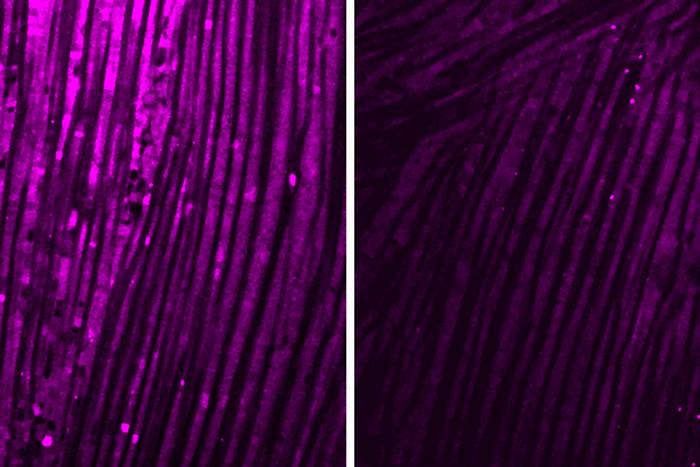Infections and neurodegenerative diseases cause inflammation in the brain. But for unknown reasons, patients with brain inflammation often develop muscle problems that seem to be independent of the central nervous system. Now, researchers at Washington University School of Medicine in St. Louis have revealed how brain inflammation releases a specific protein that travels from the brain to the muscles and causes a loss of muscle function.

Credit: SHUO YANG
Infections and neurodegenerative diseases cause inflammation in the brain. But for unknown reasons, patients with brain inflammation often develop muscle problems that seem to be independent of the central nervous system. Now, researchers at Washington University School of Medicine in St. Louis have revealed how brain inflammation releases a specific protein that travels from the brain to the muscles and causes a loss of muscle function.
The study, in fruit flies and mice, also identified ways to block this process, which could have implications for treating or preventing the muscle wasting sometimes associated with inflammatory diseases, including bacterial infections, Alzheimer’s disease and long COVID.
The study is published July 12 in the journal Science Immunology.
“We are interested in understanding the very deep muscle fatigue that is associated with some common illnesses,” said senior author Aaron Johnson, PhD, an associate professor of developmental biology. “Our study suggests that when we get sick, messenger proteins from the brain travel through the bloodstream and reduce energy levels in skeletal muscle. This is more than a lack of motivation to move because we don’t feel well. These processes reduce energy levels in skeletal muscle, decreasing the capacity to move and function normally.”
To investigate the effects of brain inflammation on muscle function, the researchers modeled three different types of diseases — an E. coli bacterial infection, a SARS-CoV-2 viral infection and Alzheimer’s. When the brain is exposed to inflammatory proteins characteristic of these diseases, damaging chemicals called reactive oxygen species build up. The reactive oxygen species cause brain cells to produce an immune-related molecule called interleukin-6 (IL-6), which travels throughout the body via the bloodstream. The researchers found that IL-6 in mice — and the corresponding protein in fruit flies — reduced energy production in muscles’ mitochondria, the energy factories of cells.
“Flies and mice that had COVID-associated proteins in the brain showed reduced motor function — the flies didn’t climb as well as they should have, and the mice didn’t run as well or as much as control mice,” Johnson said. “We saw similar effects on muscle function when the brain was exposed to bacterial-associated proteins and the Alzheimer’s protein amyloid beta. We also see evidence that this effect can become chronic. Even if an infection is cleared quickly, the reduced muscle performance remains many days longer in our experiments.”
Johnson, along with collaborators at the University of Florida and first author Shuo Yang, PhD — who did this work as a postdoctoral researcher in Johnson’s lab — make the case that the same processes are likely relevant in people. The bacterial brain infection meningitis is known to increase IL-6 levels and can be associated with muscle issues in some patients, for instance. Among COVID-19 patients, inflammatory SARS-CoV-2 proteins have been found in the brain during autopsy, and many long COVID patients report extreme fatigue and muscle weakness even long after the initial infection has cleared. Patients with Alzheimer’s disease also show increased levels of IL-6 in the blood as well as muscle weakness.
The study pinpoints potential targets for preventing or treating muscle weakness related to brain inflammation. The researchers found that IL-6 activates what is called the JAK-STAT pathway in muscle, and this is what causes the reduced energy production of mitochondria. Several therapeutics already approved by the Food and Drug Administration for other diseases can block this pathway. JAK inhibitors as well as several monoclonal antibodies against IL-6 are approved to treat various types of arthritis and manage other inflammatory conditions.
“We’re not sure why the brain produces a protein signal that is so damaging to muscle function across so many different disease categories,” Johnson said. “If we want to speculate about possible reasons this process has stayed with us over the course of human evolution, despite the damage it does, it could be a way for the brain to reallocate resources to itself as it fights off disease. We need more research to better understand this process and its consequences throughout the body.
“In the meantime, we hope our study encourages more clinical research into this pathway and whether existing treatments that block various parts of it can help the many patients who experience this type of debilitating muscle fatigue,” he said.
###
Yang S, Tian M, Dai Y, Wang R, Yamada S, Feng S, Wang Y, Chhangani D, Ou T, Li W, Guo X, McAdow J, Rincon-Limas DE, Yin X, Tai W, Cheng G, Johnson A. Infection and chronic disease activate a systemic brain-muscle signaling axis that regulates muscle function. Science Immunology. July 12, 2024.
This work is supported by the National Institutes of Health (NIH), grant numbers R01 AR070299 and R01AG059871; the National Key Research and Development Plan of China, grant numbers 2021YFC2302405, 2021YFC2300200, 2022YFC2303200, 2022YFC2303400 and 2022YFE0140700; the National Natural Science Foundation of China, grant numbers 32188101, 82271872, 32100755, 32172940 and 82341046; the Shenzhen San-Ming Project for Prevention and Research on Vector-borne Diseases, grant number SZSM202211023; the Yunnan Provincial Science and Technology Project at Southwest United Graduate School, grant number 202302AO370010; the New Cornerstone Science Foundation through the New Cornerstone Investigator Program; the Xplorer Prize from Tencent Foundation; the Natural Science Foundation of Heilongjiang Province, grant number JQ2021C005; the Science Fund Program for Distinguished Young Scholars (Overseas); and the Shenzhen Bay Laboratory Startup Fund, grant number 2133011.
About Washington University School of Medicine
WashU Medicine is a global leader in academic medicine, including biomedical research, patient care and educational programs with 2,900 faculty. Its National Institutes of Health (NIH) research funding portfolio is the second largest among U.S. medical schools and has grown 56% in the last seven years. Together with institutional investment, WashU Medicine commits well over $1 billion annually to basic and clinical research innovation and training. Its faculty practice is consistently within the top five in the country, with more than 1,900 faculty physicians practicing at 130 locations and who are also the medical staffs of Barnes-Jewish and St. Louis Children’s hospitals of BJC HealthCare. WashU Medicine has a storied history in MD/PhD training, recently dedicated $100 million to scholarships and curriculum renewal for its medical students, and is home to top-notch training programs in every medical subspecialty as well as physical therapy, occupational therapy, and audiology and communications sciences.
Journal
Science Immunology
DOI
10.1126/sciimmunol.adm7908
Method of Research
Experimental study
Subject of Research
Animals
Article Title
Infection and chronic disease activate a systemic brain-muscle signaling axis
Article Publication Date
12-Jul-2024




